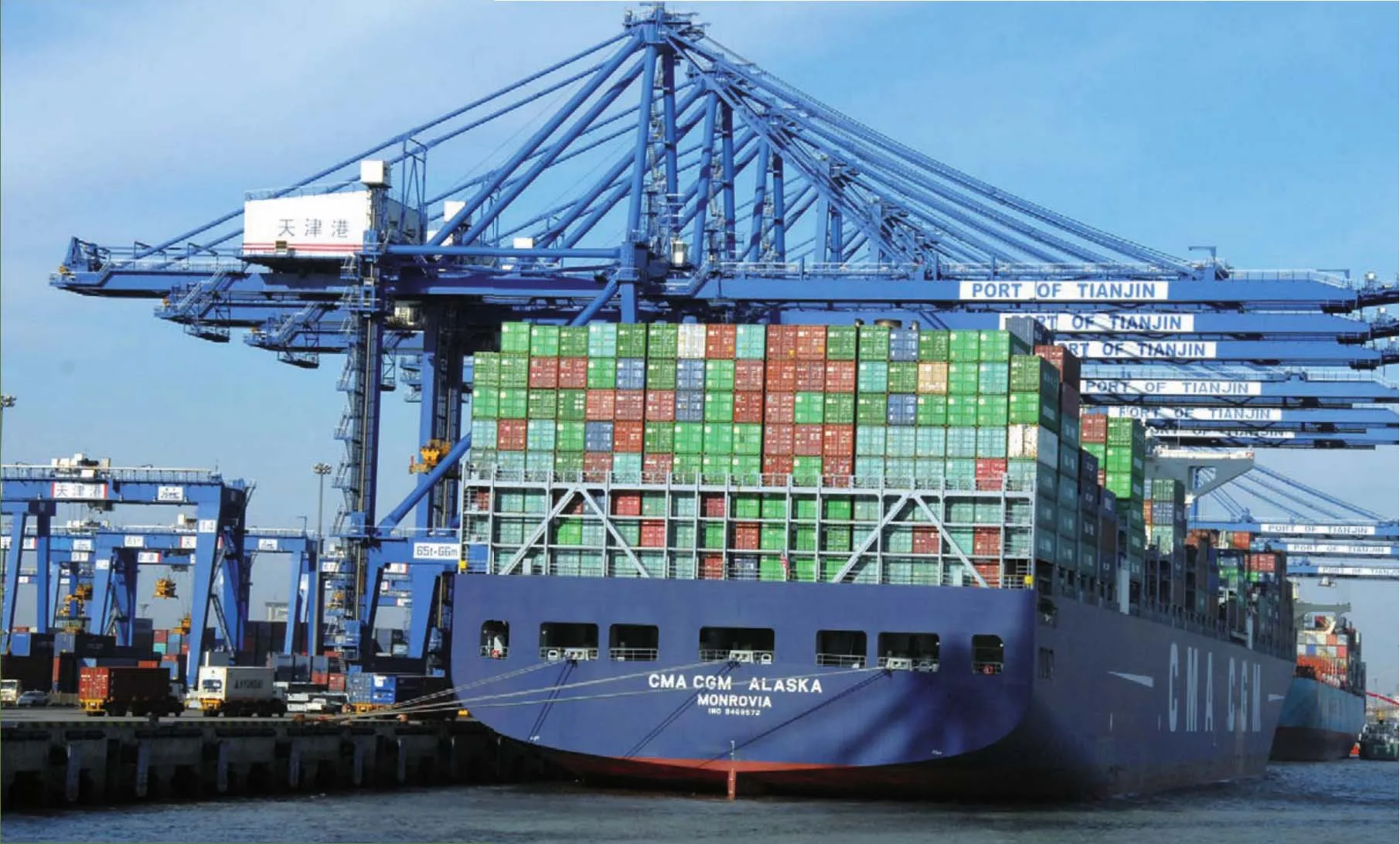Trade Advantages
2012-10-14本刊编辑部
Trade Advantages
As the world’s economic growth slows, China fi nds itself confronting the twin challenge of the “re-industrialization” of developed countries and the shift of traditional labor-intensive industries to cheaper emerging developing nations. What are China’s advantages and what strategies can the country adopt to remain competitive? Mei Xinyu, an associate research fellow with the Chinese Academy of International Trade and Economic Cooperation under the Ministry of Commerce, shared his views in an article forBeijing Review. Edited excerpts follow:
As the world’s largest trading nation, its largest exporter and second largest importer, China wields extensive influence on global trade and the world economy. China’s advantages of course lie not only in the stable foreign trade policy decided by the recently held Central Economic Work Conference, but also in the strength and resilience of a broadbased and fast-growing economy.
The country’s primary advantage comes from its stable macro-economy. The Chinese economy has generally realized a soft landing following a period of extremely rapid economic growth. While China did confront severe in fl ationary pressures in 2011, as well as a brief drop in the value of the renminbi exchange rate, China’s fi nancial status is the most stable of the world’s major economies and leading emerging markets. While China still faces risks related to local fi nancing platforms and potential non-performing loans in the banking sector, the overall assets status of the Chinese banking system is still sound, and China’s rate of inflation remains lower than India’s and those of other hot emerging markets by several percentage points.

Although pressure for renminbi depreciation continues to accumulate, the yuan is still stable compared with most emerging market currencies, many of which are now nearing currency crisis levels.
Among the largest emerging economies—BRICS—in the first nine months of 2011, only China’s yuan appreciated by more than 3 percent in the inter-bank foreign exchange market. In the other four BRICS countries, the Russian ruble depreciated by 4.06 percent, the Brazilian real lost 8.01 percent of its value, while the Indian rupee and South African rand devalued by 8.5 percent and 15.7 percent, respectively.
In September alone, the Brazilian real depreciated by 16 percent against the U.S.dollar. The Brazilian central bank, which has worked for years to curb the appreciation of the real, had to announce, on September 22,that it was selling $2.75 billion worth of the dollars to counteract the depreciation of the real. Since July 2011 the Indian rupee has depreciated by more than 20 percent.
The stability of China’s macro-economy makes the country’s industries more competitive. Corporations are keen to invest in China because they face much lower risks in terms of long-term strategic planning.
While currency depreciation in emerging developing countries such as Viet Nam and India is often seen as giving their manufacturing industries an advantage over China, currency depreciation alone does not necessarily make a country’s exports more competitive.
Serious depreciation usually means that in fl ation will rise sharply as imports become more expensive. Rises in the cost of imports not only disrupt the operations of companies but also reduce people’s quality of life, causing unrest and the possibility of strikes.
Since export-oriented enterprises in developing countries often rely heavily on foreign currency fi nancing, serious depreciation of the domestic currency increases local financing costs, damaging companies’ balance sheets and even causing the bankruptcy of enterprises. The debt crisis that swept most developing countries in the 1980s and the currency/financial crises that hit emerging economies in the 1990s were largely the result of currency depreciation and high inflation.This demonstrates the powerful adverse effects depreciation can have.
In the meantime, Chinese industries have greatly improved their competitiveness and standing in the international market. Local companies have upgraded their technologies,increased their market shares and begun making overseas direct investments.

TRADING GIANT:A large container cargo ship stops at Tianjin Port in north China. China wields extensive in fl uence on global trade and world economy
The success of these measures can be seen in the significant increase in the price of Chinese exports last year. In the fi rst eight months of 2011, the average price of goods exported by China rose 10.3 percent, which was 9.1 percentage points higher than in the same period of 2010. The prices of traditional laborintensive products saw particularly substantial rises, with those of textiles and garments rising by 24.7 percent and shoes by 18.5 percent.
However, during this period, despite these price hikes, the market share of “Made in China” goods didn’t drop markedly, and the ultimate selling prices in export destinations didn’t rise significantly, either. This means that China’s exporters are now able to claim a larger share of the international value chain,an indication of their greater competitiveness and pro fi tability.
China is now gradually moving beyond the stage of relying solely on price competitiveness, and the country is now using its advantages in human resources, the ef fi ciency of its public services, infrastructure and industrial support facilities to attract business. Even the pressure of rising costs can be digested in the medium term by regional industrial transfer within China. Since China is a country with uneven regional development, the costs of manpower and land in central and western regions are much lower than those in the developed eastern region. In 2009 the per-capita GDP of Shanghai was 78,989 yuan($12,518.07), while in central China’s Hubei Province, it was only 22,677 yuan ($3,593.82),28.7 percent of the former. In 2010, the percapita disposable income of urban residents in Shanghai was 31,838.1 yuan ($5,045.65),but in Hubei it was only 16,058.4 yuan($2,544.91), 50.4 percent of the former.
Great achievements have already been made in terms of bringing about a regional industrial transfer within China. Since 2006 the growth of exports from central and western regions has been higher than the national average. The growth of the foreign trade volume of west China’s Chongqing Municipality has been higher than the national average since 2006. In 2010, the foreign trade volume of the whole country grew by 24.3 percent, while that of Chongqing soared by 110.4 percent, with exports growing 112.5 percent. Compared with the coastal areas of some emerging developing nations such as Viet Nam and India, China’s inland areas face geographic disadvantages, but most of these disadvantages can be made up for by advances in transport infrastructure and improving the efficiency of customs clearance procedures.
That China’s foreign trade keeps growing is good news for both the international trade system and China’s trading partners.Even countries and enterprises competing with China will ultimately benefit from its growth. China alone contributes more than 10 percent to the global trade volume,and the rapid growth of Chinese trade has brought opportunities to all the world’s economies.
According to figures from the General Administration of Customs of China and the WTO, from 2000 to 2008, world imports grew at an average annual rate of 12 percent, and the average annual import growth rate of the United States, the European Union, Japan, Russia, Brazil and India was 7 percent, 12 percent, 6 percent, 21 percent,14 percent and 14 percent, respectively,while that of China was 22.4 percent. In 2009, world imports shrank by 24 percent,but China’s imports only dropped by 11.2 percent. In 2010 China’s imports surged by 38.7 percent. In the fi rst 11 months of 2011 China’s imports increased 26.4 percent year on year, which was 5.3 percentage points higher than the growth of exports in the same period. With the soft landing of the Chinese economy and with China’s new drive to expand the volume of its imports in order to balance its foreign trade, nations seeking to expand their exports to China will see more opportunities in 2012.
Despite facing significant pressures,China’s foreign trade grew strongly in the fi rst 11 months of 2011: The total trade volume hit$3.31 trillion, up 23.6 percent year on year;total exports were valued at $1.72 trillion and imports at $1.59 trillion, growing by 21.1 percent and 26.4 percent, respectively, year on year. The trade surplus stood at $138.4 billion. It is believed that in 2012 China’s foreign trade will continue to grow, and though growth will be slower than in previous years the country will remain the largest trading nation in the world.
